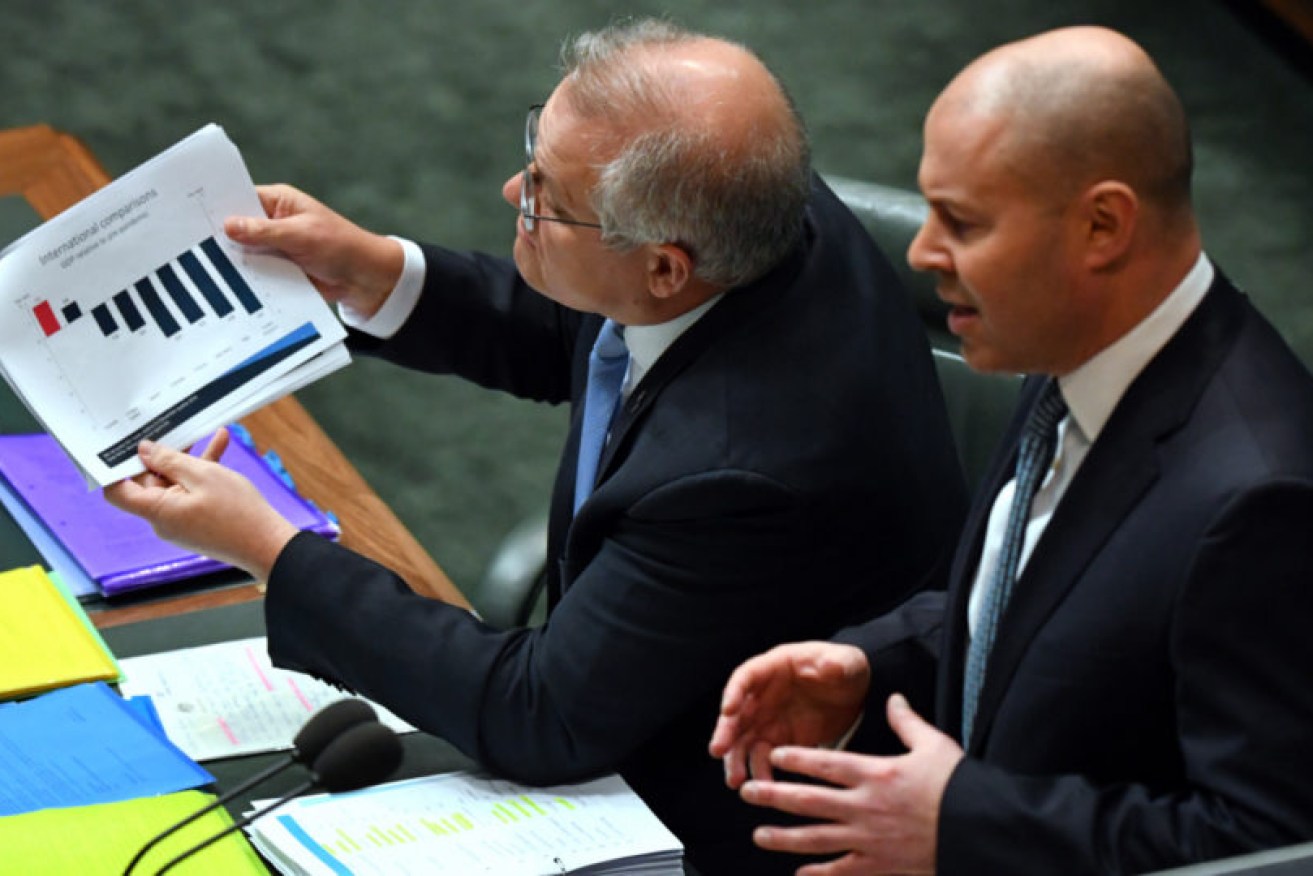‘Sharp change’: Omicron shreds government MYEFO forecasts as consumers pull back


Omicron has blown the government's expectations for the economy out of the water. Photo: AAP
The Omicron outbreak has shredded the Morrison government’s most recent economic forecasts, with surging case numbers dashing hopes of a New Year consumer spending boom, economists have said.
Just a month after Treasurer Josh Frydenberg talked up the prospect of an economic recovery in early 2022, consumer confidence has fallen and real-time data has indicated a return to lockdown-like spending patterns.
Essential supply chains have also come under pressure, with supermarkets lacking the staff needed to refill shelves and small businesses calling for a return to lockdown-style financial support.
Indeed APAC economist Callam Pickering said it’s a very different picture to the one Mr Frydenberg envisaged on December 16 when the mid-year economic update was published, saying the forecasts are “very dated”.
“[MYEFO] has little relevance to what we’re going to experience over the next couple of months,” he said.
“We’ve seen a very sharp change in conditions.”
BIS Oxford senior economist Sean Langcake agreed, saying economic conditions are now much weaker than the government had expected.
“This episode has not played out as they expected. That’s the reality,” Mr Langcake said.
“They would be downgrading if they were doing the forecasts today.”
On Monday, Prime Minister Scott Morrison admitted Omicron had spread faster and caused more disruption than the government had expected.
“[Omicron] increased higher than the estimates that we saw,” he said.
Omicron weighs on consumer recovery
Treasury’s rosy models of just a month ago predicted a 3.75 per cent rise in real gross domestic product (GDP) in 2021-22 and a fall in the unemployment rate from 4.6 per cent to 4.25 per cent by July.
The forecasts were predicated on consumers spending big over Christmas and early 2022, as well as on the assumption that Omicron would not force governments to reinstate movement restrictions.
But although lockdowns haven’t returned, businesses are still reporting disruptions to trade as hundreds of thousands of workers isolate with COVID-19 and consumers stay away from the shops.
ANZ data published last week revealed consumer spending in Victoria and New South Wales is now near the levels seen during the Delta lockdowns in 2021.
Spending in Sydney was particularly weak, dropping to the lowest level since COVID began despite no widespread restrictions on movement.
Tweet from @AdelaideTimbrel
The negative mood among consumers was supported by consumer confidence data published by ANZ and Roy Morgan on Tuesday.
Their closely followed index fell 2.2 per cent in the first week of January to 106 points.
Although that is still in positive territory, it is below the 32-year long-run average.
Mr Langcake said many consumers are clearly hesitant to hit the shops or make other large investments while Omicron spreads rapidly across Australia.
“There has been a strong pullback in activity,” he said.
“There’s a lot of people playing wait and see on the state of the health system.”
That said, Mr Langcake and Mr Pickering warned against reading too much into the spending data, saying that high household savings should support a bounce in consumer spending once Omicron infections peak.
CommSec chief economist Craig James made a similar point, arguing that goods shortages and higher prices were crimping spending.
“Aussie consumers are alert, not alarmed,” Mr James said.
But the future is less clear.
Mr Pickering said the Omicron wave could have a longer-lasting effect on consumer sentiment than previous outbreaks in Australia.
That’s because case numbers were much lower when past lockdowns ended – leading to fast economic rebounds – but now COVID-19 is pervasive throughout the community and unlikely to go anywhere any time soon.
“That could weigh on economic activity in a different way than we saw during lockdown,” Mr Pickering said.
“You might not get the same short and sharp decline in activity, but you could see a dampening over a number of months.
“Our ability to return to normal isn’t going to be the same as it was when the lockdowns lifted.”
RBA patient as market forecasts fall
Mr Langcake said economists such as himself are now downgrading their economic growth forecasts to reflect the effects of the Omicron outbreak.
Citi economists have already slashed their first-quarter GDP prediction from 2.3 per cent to 1.3 per cent, making the government forecasts from December look particularly dated.
Commonwealth Bank economists said on Tuesday that the outlook for January has been negatively affected by Omicron, with households “now taking a more risk-averse approach” to the economy than in 2021.
Tweet from @ShaneOliverAMP
Economists also said it’s now less likely that the Reserve Bank will raise mortgage rates in 2022, as some major banks predicted late last year.
Although RBA governor Philip Lowe consistently played down the idea of a 2022 rate rise, some economists thought the recovery would be too strong for the central bank to keep the official interest rate at a record low of 0.1 per cent for another year.
Mr Langcake said such a view is now much harder to justify, with the RBA signalling a willingness to be patient and wait for domestic demand to recover later in 2022 and into 2023.
“The RBA has always wanted to wait for a goldilocks situation,” he said.
“They want inflation to be driven by wages growth.”
Annual wages growth is only expected to pick up gradually, with the RBA forecasting growth to lift from 2.1 per cent today to 2.5 per cent by 2023.
But Mr Pickering said Omicron is likely to slow the pace of wages growth, because broader economic activity will now be lower than otherwise.
“It’s probably a little bit too soon to get a good feeling for what impact Omicron and the latest outbreak has had on the job market,” he said.
“Realistically, this outbreak means the economy itself is going to be weaker than it otherwise would have been.
“All else equal, that should lead to lower wages growth.”








